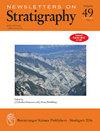Tephrochronology and chronostratigraphy of the Miocene Chilcatay and Pisco formations (East Pisco Basin, Peru)
IF 2.1
3区 地球科学
Q1 GEOLOGY
引用次数: 34
Abstract
Strata of Chilcatay and Pisco formations exposed in the Ica Desert (East Pisco Basin, southern Peru) preserve one of the most complete and rich records of Miocene marine vertebrates of the world. Despite its exceptional importance, the chronostratigraphy of these fossil-bearing deposits has been only sporadically studied in the literature until recently. This work presents a detailed reconstruction of the chronostratigraphic framework, achieved by mapping and measuring of seven sections (totaling a height of almost 1000 m) of the Miocene Chilcatay and Pisco formations along the western side of the Ica River. The Chilcatay Formation consists of two allomembers, namely Ct1 and Ct2, bounded at the base by unconformities CE0.1 and CE0.2, respectively. Similarly, the immediately overlying Pisco Formation is divided into allomembers P0, P1, and P2, bounded at the base by unconformities PE0.0, PE0.1 and PE0.2, respectively. The new 39Ar–40Ar results presented here, combined with ages of previous work, provide precise constraints on the age of several stratigraphically referenced volcanic ash layers intercalated in the studied fossil-bearing succession, placing its vertebrate fossil fauna within a refined temporal framework and laying the solid ground for its detailed regional and global comparison. The ages of the allomembers, and thus their associated faunas, can be reliably estimated by the combination of 39Ar–40Ar dating on tephra layers with diatom biostratigraphy. In the study area, two methods are mutually consistent and constrain the deposition of the Chilcatay Formation between 19.2 and 18.0 Ma, that of P1 between 9.5 and 8.6 Ma, and that of P2 between 8.4 and 6.7 Ma. In the absence of direct dating of the P0 allomember, which lacks both preserved tephra suitable for 39Ar–40Ar dating and microfossils, its age can be constrained to the temporal gap between the youngest age available from the underlying Chilcatay strata (18.0 Ma) and the oldest age available from the overlying P1 strata (9.5 Ma).秘鲁东皮斯科盆地中新世Chilcatay和Pisco组的温度年代学和年代地层学
在伊卡沙漠(秘鲁南部东皮斯科盆地)暴露的Chilcatay和Pisco地层保存了世界上最完整和最丰富的中新世海洋脊椎动物记录之一。尽管具有特殊的重要性,但这些含化石矿床的年代地层学直到最近才在文献中得到零星的研究。这项工作通过绘制和测量伊卡河西侧中新世Chilcatay和Pisco地层的七个剖面(总高度近1000米),详细地重建了年代地层框架。Chilcatay组由Ct1和Ct2两组组成,基底处分别为CE0.1和CE0.2不整合面。同样,上覆的Pisco组也被划分为P0、P1和P2三组,分别以不整合面PE0.0、PE0.1和PE0.2为界。本文提出的新的39Ar-40Ar结果,结合先前工作的年龄,提供了对研究的含化石演替中插入的几个地层学参考火山灰层年龄的精确限制,将其脊椎动物化石动物群置于精细的时间框架内,并为其详细的区域和全球比较奠定了坚实的基础。结合硅藻生物地层学和双硅藻层的39Ar-40Ar定年,可以可靠地估计异位元的年龄,从而确定与之相关的动物群。在研究区,两种方法相互一致,约束了Chilcatay组沉积在19.2 ~ 18.0 Ma、P1组沉积在9.5 ~ 8.6 Ma、P2组沉积在8.4 ~ 6.7 Ma。由于没有对P0 allomember进行直接测年(既缺乏适合39Ar-40Ar测年的保存的tephra,也缺乏微化石),其年龄可以限制在Chilcatay地层的最年轻年龄(18.0 Ma)与上覆P1地层的最古老年龄(9.5 Ma)之间的时间差距。
本文章由计算机程序翻译,如有差异,请以英文原文为准。
求助全文
约1分钟内获得全文
求助全文
来源期刊

Newsletters on Stratigraphy
地学-地质学
CiteScore
5.50
自引率
4.50%
发文量
22
审稿时长
>12 weeks
期刊介绍:
Newsletters on Stratigraphy is an international, peer-reviewed journal with a focus on stratigraphic issues that are relevant for a broad geoscientific community. Papers published in Newsletters on Stratigraphy use (and ideally integrate) stratigraphic methodologies from a wide field of disciplines, including (but not limited to) biostratigraphy, chronostratigraphy, chemostratigraphy, and magnetostratigraphy.
The results have implications for paleogeographic reconstructions, paleoceanography, paleoclimate, biotic evolution, basin development, or regional and supraregional correlation.
Papers published in Newsletters on Stratigraphy comprise original research articles, background information on ongoing work of e.g., the International Stratigraphic Commission (ICS) and the International Subcommission on Stratigraphic Classification (ISSC), and review articles. There are no page charges for the publication of regular papers.
 求助内容:
求助内容: 应助结果提醒方式:
应助结果提醒方式:


